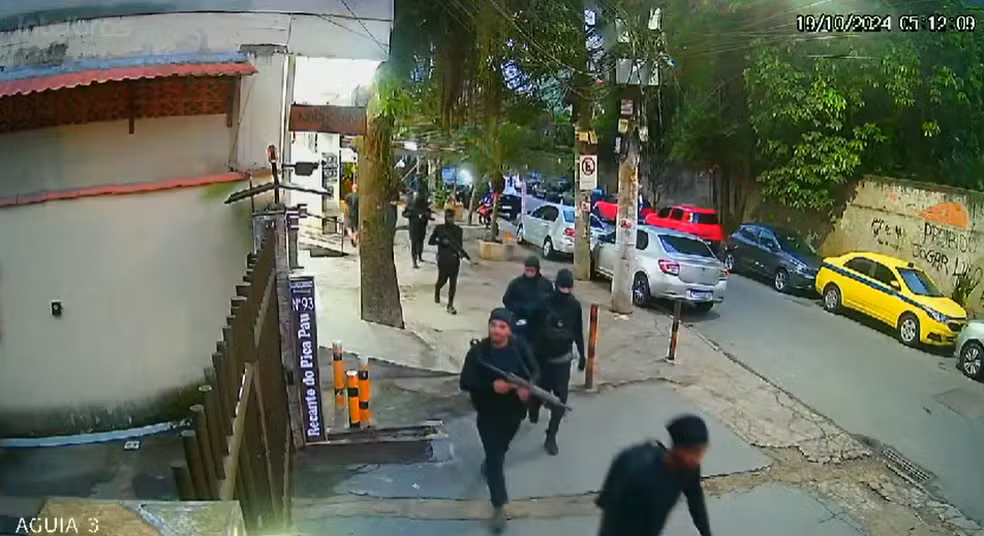The expansionist offensive led by the Red Command (CV) has transformed Baixada de Jacarepaguá into a zone marked by conflict and fear. Over the past two years, the faction has attacked at least ten communities in Rio’s new Southwest Zone, as part of a strategy to form a continuous corridor of territorial control linking Recreio dos Bandeirantes to the Tijuca Massif in Itanhangá. To resist the advance, favelas controlled by militias and the Third Pure Command (TCP) have reinforced their positions with new recruits, weapons, and fortifications. On Monday (13/10), the Military Police arrested 14 suspects and seized 12 rifles, 43 magazines, two pistols, and a revolver in an abandoned structure within the Juliano Moreira Colony, near Morro Dois Irmãos in Curicica.
This Content Is Only For Subscribers
To unlock this content, subscribe to INTERLIRA Reports.
No Reaction
The group was found with nearly a thousand rounds of ammunition, and the seized arsenal was estimated at R$1 million in value. The suspects were asleep on the second floor of a half-built structure hidden in a forested area. The lookout was caught off guard by police while distracted by his cell phone. No shots were fired, and none of the suspects resisted arrest. According to authorities, three had previous links to militia activities, while the remaining individuals had no criminal record.
Militia
Currently, between Vargem Grande, Vargem Pequena, and Itanhangá, paramilitary control is limited to the communities of Colônia, Dois Irmãos, Curicica, and Rio das Pedras—the latter considered the cradle of militias in Rio de Janeiro. Despite repeated offensives, Rio das Pedras has withstood persistent attacks from the Red Command, which has already seized neighboring territories such as Muzema, Morro do Banco, Sítio do Pai João, and Tijucas—all located along the edge of the Tijuca Forest.
Repeated Attacks
Morro Dois Irmãos has been a recurring target of CV operations. On September 28, traffickers from Cidade de Deus launched an invasion, prompting a swift police response the following day that resulted in the seizure of three rifles. The militia then exploited the weakened state of the invaders to reclaim control of the favela. Six CV members were killed, their bodies later found inside an abandoned car on Estrada dos Bandeirantes.
Gardenia Azul
The Red Command also suffered a major setback during a Civil Police operation on October 9. Ygor Freitas de Andrade, known as Matuê, identified as one of the faction’s “warriors,” was killed in a shootout with officers in Morro da Chacrinha, Praça Seca.Matuê, labeled the drug boss of Gardênia Azul and Cidade de Deus, had been charged with the 2023 murder of a 23-year-old woman. The crime was apparently ordered by Edgar Alves de Andrade, alias Doca, a senior CV leader. According to investigators, Matuê was also involved in the killing of CORE officer José Antônio Lourenço, 39, murdered in Cidade de Deus.
Base in Vila Kennedy
Using Vila Kennedy as a base for their raids, drug traffickers have been waging an intense war of war over the Jardim Bangu and Catiri areas in Rio’s West Zone for at least two years. The war, which is spreading panic among residents, is part of the faction’s expansionist movement, which is attempting to form a “belt” around the Gericinó Complex, a conglomerate of 22 prison units also located in the city’s West Zone. Catiri has become a strategic point for the formation of the belt because of its proximity to the prisons. From Vila Kennedy, they also deploy to carry out operations in Guaratiba, Santa Cruz, and Campo Grande.
Jacarepaguá Base
In the communities of the Itanhangá region, in Rio’s Southwest Zone, the climate is no different. Long considered the most peaceful in the city, they now suffer from constant turf wars. Currently, drug trafficking completely controls Morro do Banco, Tijuquinha, and Muzema, previously dominated by paramilitary groups, as well as a small portion of Rio das Pedras, the birthplace of Rio’s militias. The CV’s desire to control the Greater Jacarepaguá region has been ongoing for about a decade. For the faction, besides being a show of force, this area is strategic because it allows the organization to form a “belt” around the Tijuca Forest—which would facilitate escapes in the event of police operations or invasions by rivals. The CV’s interest in the region is justified because it is from Jacarepaguá that attacks are launched to reach the entire southwest and west zones of the city.
Analysis:
The recent wave of territorial clashes in Baixada de Jacarepaguá reveals how Rio de Janeiro’s criminal landscape continues to evolve into a complex and volatile network of competing armed groups. The Red Command’s expansionist campaign toward the Tijuca Massif illustrates a strategic shift: rather than merely defending drug-selling points, the faction seeks to establish a continuous territorial corridor connecting strategic urban zones. This move aims to secure escape routes, logistical control, and access to emerging economic areas in the city’s Southwest Zone. The choice of this region—previously known for its green spaces and urban growth potential—demonstrates how organized crime adapts to exploit real estate expansion and weak state presence.
The resistance from militias and the Third Pure Command reflects the multidimensional nature of the conflict. Unlike traditional drug factions, militias combine territorial control with economic exploitation, charging residents for services such as security, transportation, and electricity. This business model has given them deep social roots, particularly in communities like Rio das Pedras and Curicica, where they continue to withstand CV offensives.




